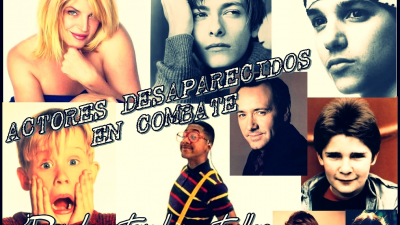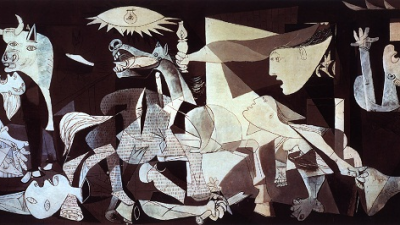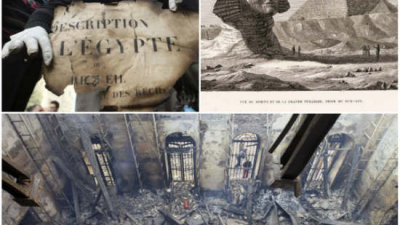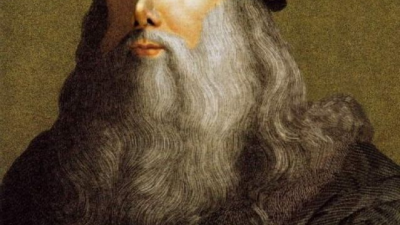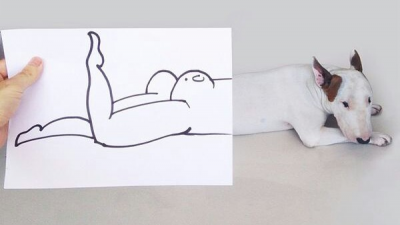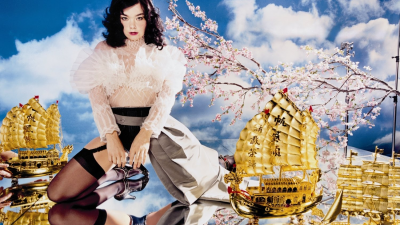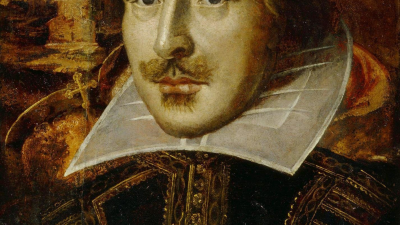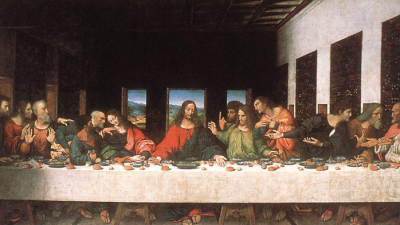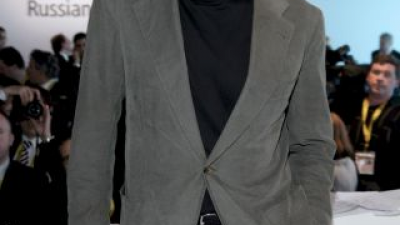Artistic works by Miguel Angel
|
NEWS
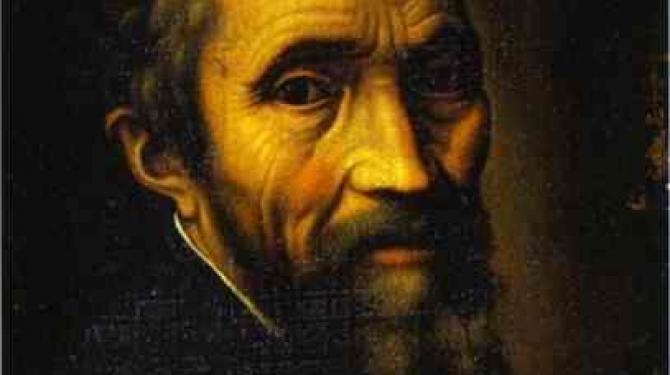
Source: listas.20minutos.es
Miguel Angel was one of the greatest creators of all art history, and together with Leonardo Da Vinci, the most prominent figure of the Italian Renaissance. As an architect, painter, sculptor and poet, he exerted a great influence both on his contemporaries and on all Western art after his time.
TOP 31:
Eritrean Sibyl
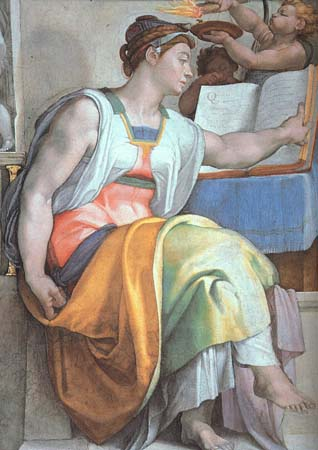
The Eritrean sibyl was the prophetic priestess of Greek mythology, residing in Ionia, west of the Anatolian peninsula. She was a native of Caldea, south of Babylon, being the daughter of Berosus and Erimanta. The wise Apollodorus of Athens is cited as a reference of the facts of this famous sibyl, which he credits as a diviner of the Trojan War, with the destruction of the city and the work of Homer. It is said that the Eritrean sibyl popularized acrostics through verses written on vegetale leaves
TOP 30:
Farnese Palace (Rome)
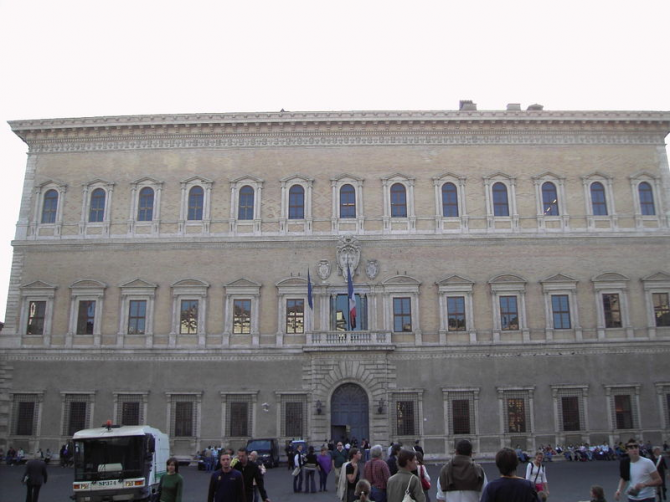
In the construction of the Farnesio Palace, Michelangelo replaced Antonio da Sangallo the Younger, who was the director of the works at the time of his death in 1546. The building was under construction at the level of the second floor. Buonarroti finished the facade before making the lateral and posterior bodies, and raised the height of the second floor to unify them with the same measure as the lower ones. The cornice of the building, which Sangallo had foreseen narrower, replaced it with a larger one with ornamental elements, where the Doric, Ionic, and Corinthian orders are mixed. The rhythm of the facade also changed with the revision of the central window, which provided a larger lintel with the prolongation of the entablature, on which it placed a giant shield of more than three meters high. The later part of the work was finished years later by Giacomo della Porta. [
TOP 29:
Piedad Rondadini
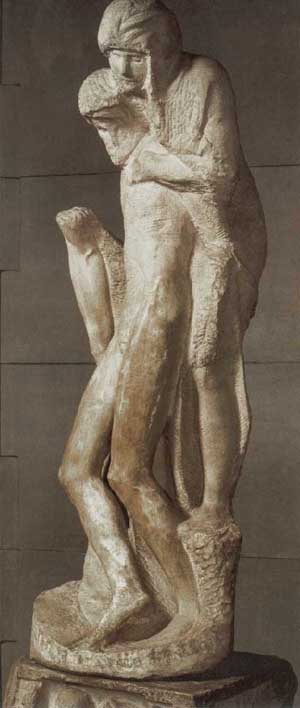
Pieta Rondanini is located in the Sforzesco Castle museum in Milan. Considered as the last work sculpted by Michelangelo, since he was working on it until three days before he died. In August 1561 Miguel Ángel gave the figure, still in execution, to his servant Antonio del Francese, although he continued working on it until his death. Later it was acquired by the Marquis de Rondanini, staying in his palace for a long time. Finally, in 1952, it was acquired by the city council of Milan, which assigned it to the Civic Museum of the Sforzesco Castle. The sculptural group is unfinished, and the work is clearly seen to have been done in various stages. It has completely finished parts and others still under development, such as the face of the Virgin.
TOP 28:
Porta Pía (Rome)
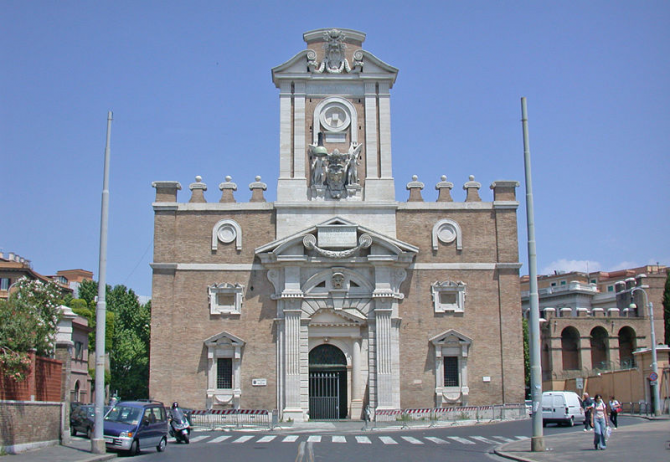
Pope Pius IV commissioned a project for the Porta Pia, the artist presented three; The Pope chose the one with the lowest cost and construction began in 1561. The door was built during the urban remodeling process carried out by Pope Pius IV. The new street that came from the Quirinal, was named Via Pia in honor of the Pope; thereafter he continued in a straight line through the Porta Pia, which crosses the city walls; Michelangelo made it in that section instead of another that was very close to the place called Nomentana. It was carried out as a great scenography, at the highest topographic point of the wall, with the façade towards the interior of the city, thereby departing from the ancient tradition of orienting the doors towards the countryside, as a presentation of the city to the visitor. The medals that were minted on the occasion of the construction of the Gate, the work of Giovanni Federico Bonzagni, show how it was originally designed. The project for the external part could not be completed by the death of Michelangelo in 1565 and the election of a new pope, Pius V, so that the works were paralyzed and the external part was solved with a simple wall and a door.[
TOP 27:
Facade of San Lorenzo (Florence)
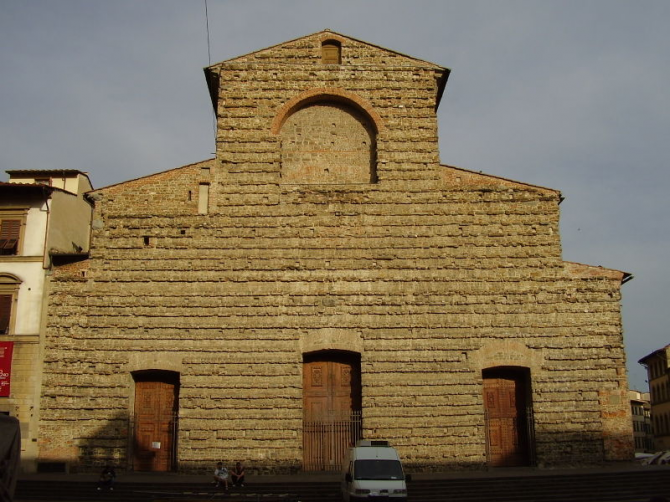
The death of Brunelleschi motivated Antonio Manetti to take charge of the work in the church of San Lorenzo but the facade was not concluded. For this reason, Michelangelo was thought to carry out this project, which today can be seen in a model preserved in the Buonarroti House, but continuous rivalries between the stonecutters prevented the plan from being implemented, remaining unfinished. Michelangelo himself wrote in 1518 in reference to this matter: "I'm dying of grief." The interior facade itself was done in an extraordinary way.
TOP 26:
The Battle of Cascina
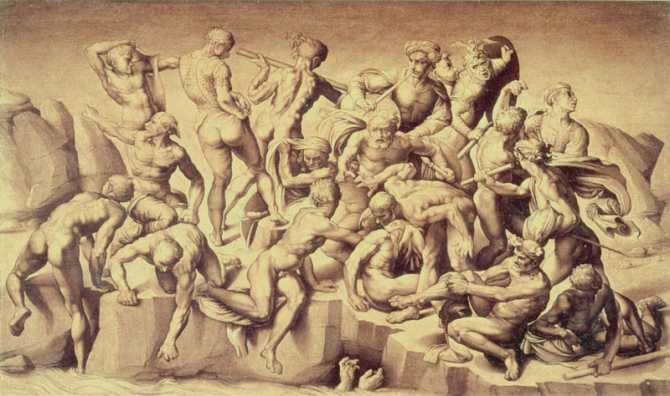
The battle of Cascina is a fresco designed by Michelangelo for the Palazzo Vecchio in Florence. He did not get to paint it and made only the previous cardboard (model), which was destroyed and is known for the copy made by Bastiano da Sangallo and for two partial engravings by Marcantonio Raimondi.
TOP 25:
Piety of Palestrina
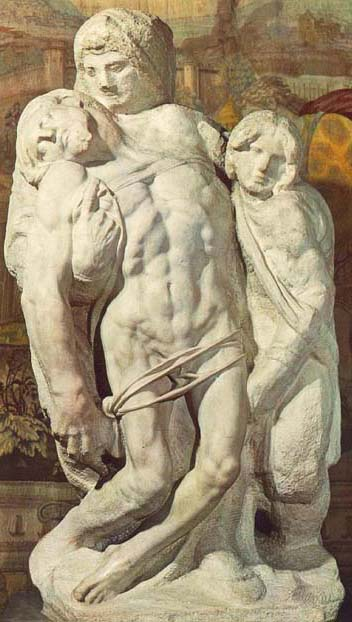
a Piedad de Palestrina is a work attributed to Michelangelo, which is located in the Gallery of the Academy of Florence, next to David, another sculpture of the artist, and consists of a sculptural group with Christ, the Virgin Mary and Mary Magdalene, coon a measure of two and a half meters high. The name of the work comes from the fact that for a time it was placed in the funeral chapel of Cardinal Antonio Barberini, inside the church of Santa Rosalia in Palestrina, where for the first time it is cited as an outline of Michelangelo in 1756 in Storia di Palestrina by Cecconi, the Italian state bought it in 1939 to exhibit it in the Gallery of the Academy in Florència.
TOP 24:
The Delphic Sibyl
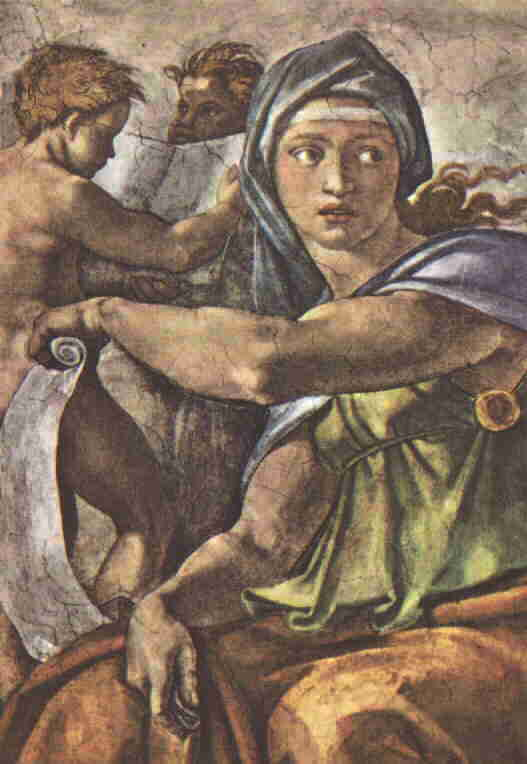
La Sibila Délfica (in Italian, Sibilla Delfica) or Sibila de Delfos, is a fresco by the Italian Renaissance painter Michelangelo in the Sistine Chapel (Vatican City). It dates from 1509. It measures 350 centimeters high and 380 cm wide. The fresco is part of a series placed at the base of the chapel in which they appear, alternating, the prophets of the Old Testament next to the pagan Sibyls. These prophets and sibyls occupy triangular spaces, and are the largest figures in the entire Sistine Chapel Vault. The Renaissance Catholic iconography maintains the sibyls because they considered that they were endowed with the power to see the future, they announced the arrival of Christ.
TOP 23:
Virgin of the Stairs or Madonna of the Stairs
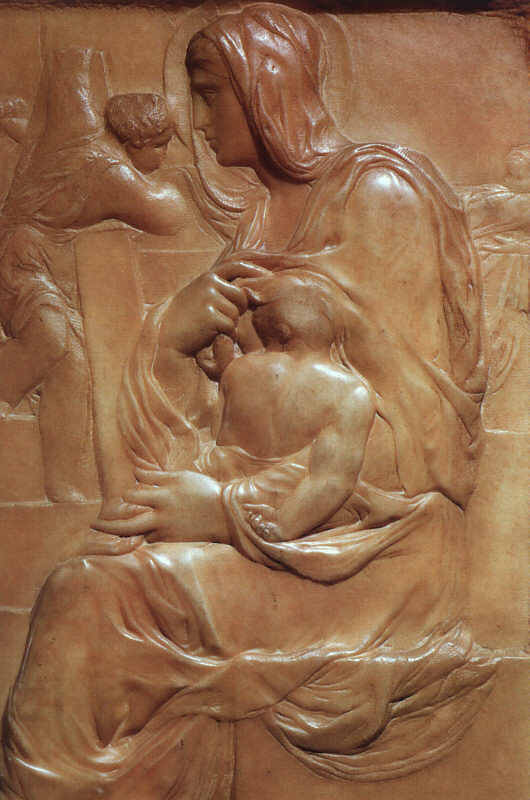
The Virgin of the stairs is a marble relief sculpture by the sculptor Michelangelo, dated around 1491 and stored in the Buonarroti House in Florence. The unfinished work has measures of 55.5 x 40 cm. It is one of the first sculptures made by Michelangelo, close to when he also executed the Battle of the Centaurs. The details of how the feet of the Virgin are made, suggest that it is really one of his first works, also prior to that of the Battle. It is worked with the same virtuous style of Donatello in the Virgen de la Leche, named stiacciato style that literally means "compressed relief".
TOP 22:
Angel holding a candlestick
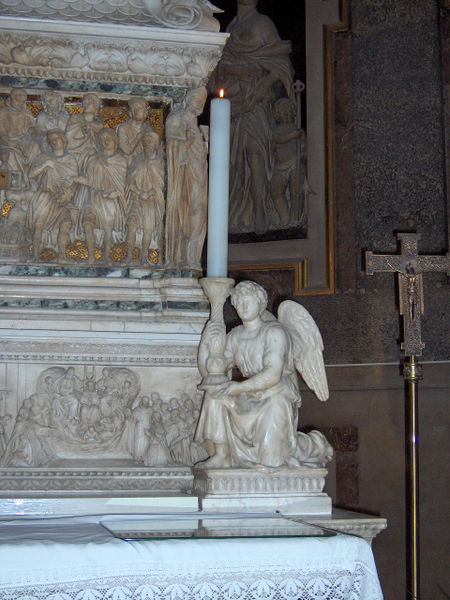
TOP 21:
Drunk bacchus
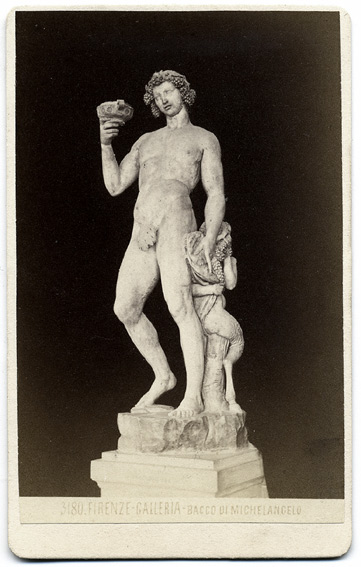
In Roman mythology Bacchus was the God of wine and mystical ecstasy, in correspondence with the Dionysus of the Greeks. Michelangelo chooses to represent the first two characteristics. Bacchus standing with the head crowned with grapes and raising a glass as if to propose a toast. He has a tilted head and an open mouth. The unstable posture of God reinforces the idea that Bacchus is drunk. The partially raised leg and the body tilted back makes it seem uncertain of its steps, wobbly in its drunkenness. The piece would swell the antique collection of the Roman banker Jacopo Galli. It is the earliest life-size sculpture by Michelangelo. The satyr detail of Bacchus in classical mythology was a divinity of nature that embodies the wild instincts of the human being under the anthropomorphic aspect, half animal, but more frequently it had goat legs and back, split hooves and small horns. The satyrs were Baco's natural companions and followed him to participate in his festivities and his sybaritic excesses. He hides behind the figure of Bacchus, and nibbles the grapes he has taken from the leopard skin that God holds. In this statue especially in the finishes of the extremities, such as the satyr leg, it was where Michelangelo begins to perfect the use of the Drill to create textured surfaces. The sculpture can be viewed from any angle.
TOP 20:
Rebel Slave
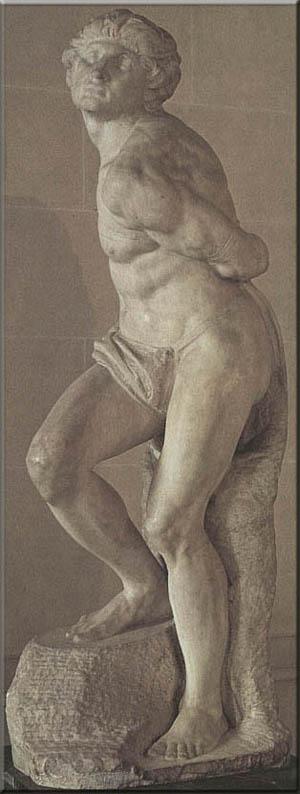
Dying Slave is a white marble sculpture created around 1513 by Renaissance sculptor Michelangelo. Together with another of the same author, called Rebel Slave, he is in the Louvre Museum in Paris. It is 229 centimeters tall. When these works were eliminated for the monument of Julius II, Michelangelo gave this sculpture along with that of the rebel Slave, in 1546 to Roberto Strozzi, who had the sculptures transported to France in April 1550. Henry II de Montmorency in 1632, he gave them to Cardinal Richelieu who had them in his castle in Poitou, where Bernini saw them. [1] They were finally confiscated by the French government in 1793 when they were intended to be sold by the widow of the last Marshal Richelieu. Since then they are in the Louvre.
TOP 19:
Capitol Square (Rome)
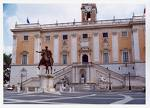
According to the "Mirabila Romae", a twelfth century guide, the Capitol was the center of the world, since from this hill the Roman Empire was ruled - the United States Congress centuries centuries later would steal the name: "The Capitol" -. In 1536 Michelangelo designed this magnificent stage to crown the Capitol, the smallest of the seven hills of Ancient Rome, but at the same time the most important since the power settled in it. From the busy Plaza Aracoeli you can reach, through the gracefully inclined stairway of Michelangelo (the Cordonata), the sudden silence of its geometrically delineated square, with its three low and harmonious buildings that act as theatrical backdrop. Michelangelo was inspired by the two millennia of the glorious history of Rome that developed on this hill. Being a sculptor, he transformed it into the showcase of the great classical Roman sculptures. We especially highlight the equestrian statue that is in the center, that of Emperor Marco Aurelio, who seems to be in an attitude of friendly conversation with the populace. Capitol Square
TOP 18:
The prophet Zacharias
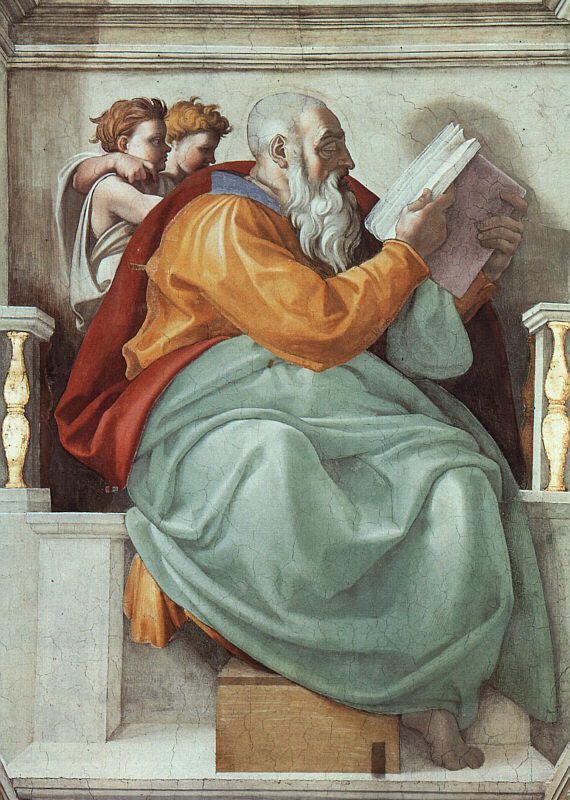
Zechariah (Hebrew: זְכַרְיָה Zekjar · yáh) is one of the minor prophets, to whom the book that bears his name is attributed. His name means Yaveh Has remembered. Zechariah calls himself the son of Berekiah the son of Idó (Zac 1: 1,7) but in other passages the name of Berekías is omitted. He was probably born somewhere in Babylon, since his prophetic activity began only seventeen years after the return from exile, and it is reasonable to think that by then he was over seventeen years old, although he was still considered young. Yahweh used Zacharias and Ageo to encourage Zerubbabel, the high priest Jeshua and the exiles who had returned to finish the reconstruction of the temple of Jehovah, even though a ban on the Persian government was still in force. Zechariah's prophecy contains messages he delivered for that purpose over a period of two years and one month. One of the prophecies contained in the book of Zechariah in chapter 11 and verses 12 and 13 makes direct reference to the price (thirty pieces of silver) that the chief priests offered to Judas for giving them to Jesus. See the Gospel of St. Matthew in chapter 26 and verse 15.
TOP 17:
Graves of the Medici Family
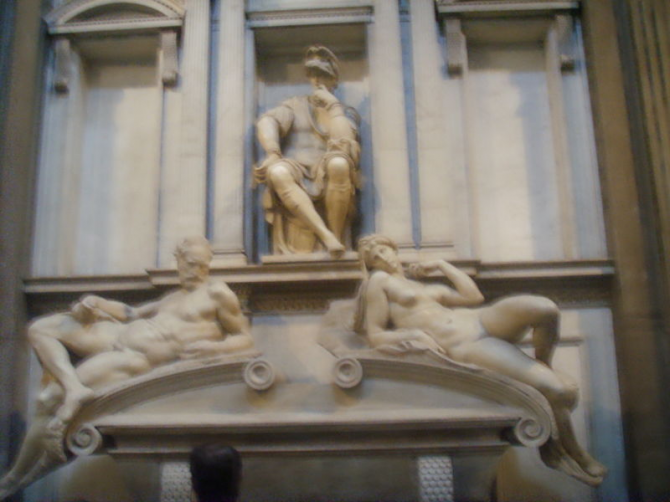
Pope Clement VII, around 1520, commissioned the project for the graves of his relatives Lorenzo the Magnificent, father of Leo X, and his brother Juliano, (father of Clement VII), and two more graves for other members of the Family: Juliano II and Lorenzo II, in the sacristy of the Basilica of San Lorenzo in Florence. The Pope proposed four graves, one on each wall of the square floor of the sacristy, a Virgin with Child and the images of Saints Cosme and Damien, which had to be placed in the center of the room on an altar. [58 ] Once the project was approved, it was not started until 1524, when the Carrara marble blocks arrived. Michelangelo applied the sculptures next to the architecture of the walls; all the moldings and cornices fulfill the function of shadow and light and, they are composed of a curvilinear sarcophagus on which there are two statues with the symbolism of time. In Lorenzo's, the Twilight, with the strokes of an aging man who still has full possession of his strength, which has a symmetrical attitude to the Aurora, which is on the right and above both, within a niche, the statue of Lorenzo, nephew of Leo X, whose head is covered with the helmet of the Roman generals; his attitude of meditation immediately made him known as "the thinker"
TOP 16:
Victory Genius
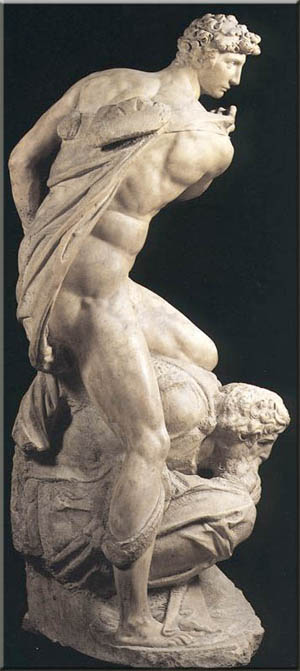
That is the case of the sculpture known as the Genius of Victory, which you can see in the Cinquecento Hall of the Palazzo Vecchio of the Plaza de la Signoria. The Genius of Victory was sculpted in marble by Michelangelo between 1532 and 1534, within a large project that occupied him several years of his life, the Tomb of Pope Julius II, which you can see in the church of San Pietro and Vincoli, in Rome, and of which another of his great masterpieces, Moses. With a height of 2.65 meters, the Genius of Victory shows us two figures in struggle, of which one is the winner. The sculpture would be integrated into the aforementioned papal sepulcher, but finally Miguel Angel had to develop another project of it and the Genius of Victory remained in the artist's studio until his death.
TOP 15:
Crucifixion of San Pedro
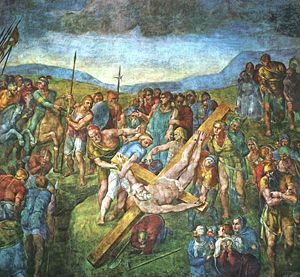
The Crucifixion of Saint Peter (in Italian, Crocifissione di San Pietro) is a fresco by the Italian Renaissance painter Michelangelo. It was executed between 1546 and 1550 on the wall of the Pauline Chapel of the Apostolic Palace, in the Vatican City. It is a fresco that measures 6.25 meters high and 6.62 meters wide. It pairs with the conversion of St. Paul and is the last fresco executed by Michelangelo. The artist portrayed St. Peter at the time when, placed upside down on the cross, it was raised by Roman soldiers. Michelangelo concentrated his attention on the description of pain and suffering. The faces of the people present are contracted in a grimace of horror, and several of the spectators seem to be going to die. Among the riders on the left, a self-portrait of Miguel Ángel himself has been recognized, on the occasion of a recent restoration
TOP 14:
Dying Slave
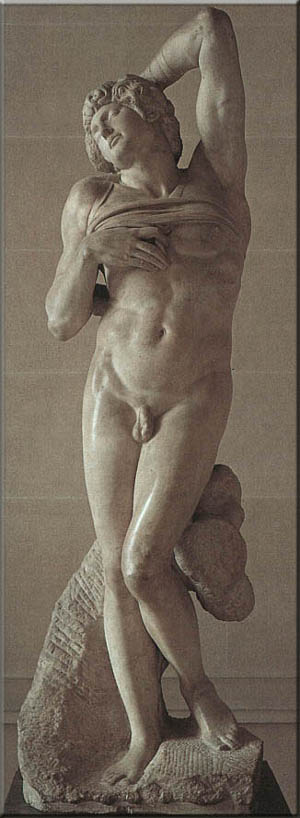
Dying Slave is a white marble sculpture created around 1513 by Renaissance sculptor Michelangelo. Together with another of the same author, called Rebel Slave, he is in the Louvre Museum in Paris. It is 229 centimeters tall. When these works were eliminated for the monument of Julius II, Michelangelo gave this sculpture along with that of the rebel Slave, in 1546 to Roberto Strozzi, who had the sculptures transported to France in April 1550. Henry II de Montmorency in 1632, he gave them to Cardinal Richelieu who had them in his castle in Poitou, where Bernini saw them. [1] They were finally confiscated by the French government in 1793 when they were intended to be sold by the widow of the last Marshal Richelieu. Since then they are in the Louvre.
TOP 13:
Laurentian Library (Florence)
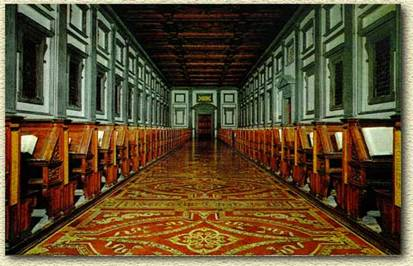
The Laurenciana Library or Medicea Laurenciana Library (in Italian: Biblioteca Mediceo Laurenziana) is one of the most important libraries in Florence and throughout Italy. It is famous for retaining approximately 11,000 manuscripts. Built in the cloister of the basilica of San Lorenzo, it was sponsored by Pope Clement VII (in the century, Julio de Médicis). During the 1520s, Michelangelo designed the reading room and lobby with the Laurentian Library access staircase, annexed to the aforementioned church, although the work did not end until several decades later and no longer under the direction of the Tuscan master. Michelangelo took as a point of reference the type of articulation of walls developed by his Florentine predecessors, but instead of faithfully following the classical canons stipulated by Greeks and Romans, Michelangelo used these motifs - columns, pediments, brackets - more Personal and expressive. The lobby or ricetto (built in 1559 by Bartolomeo Ammannati) invites silence with its blind windows of hanging and stoned stitches that join the ceiling beams. Stresses in this, the triple staircase that is summarized in a single ramp, planned by Michelangelo and is the perfect example of Mannerism Architecture. Stairs upstairs, the reading room is with repeated contraposition of rectangular and square blind openings, an individualized and recollecting insistence on study and meditation.
TOP 12:
La Sagrada Familia or Tondo Doni
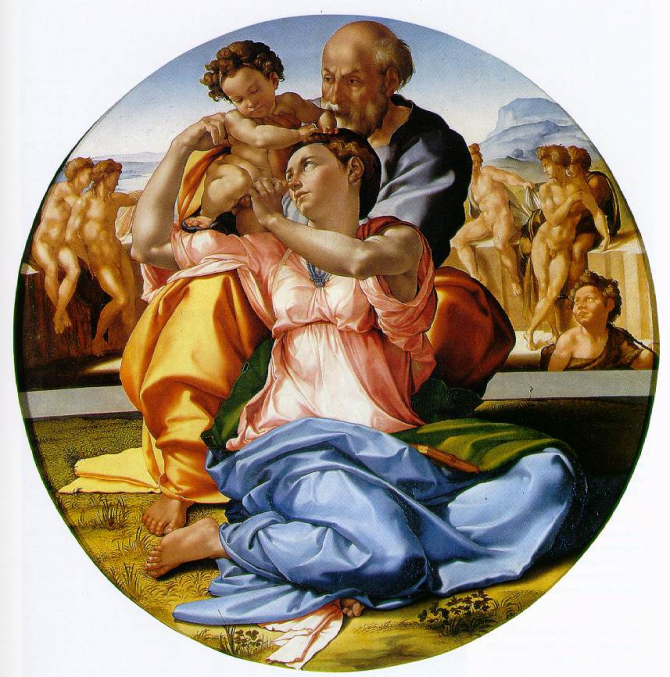
The Tondo Doni, also known as La Sagrada Familia (1504-1505), is today in the Uffizi Gallery, Florence. This tempera painting, he painted for Agnolo Doni, as a wedding gift to his wife Maddalena Strozzi. In the foreground is the Virgin with the Child and behind, Saint Joseph, of great proportions and dynamically articulated; The images treated as sculptures within a circular arrangement of 120 cm in diameter and with a pyramidal composition of the main figures are striking. The base of the triangular line is marked by the legs of the Virgin placed on her knees, with her head turned to the right, where the Child is supported by St. Joseph, with the body tilted to the left; This upper part of the painting, together with the line marked by the arms, denotes a spiral movement. The artist showed that, with the painting, he was able to express himself with the same grandeur as in the sculpture; the Tondo Doni, in fact, is considered the starting point for the birth of Mannerism
TOP 11:
The Conversion of St. Paul
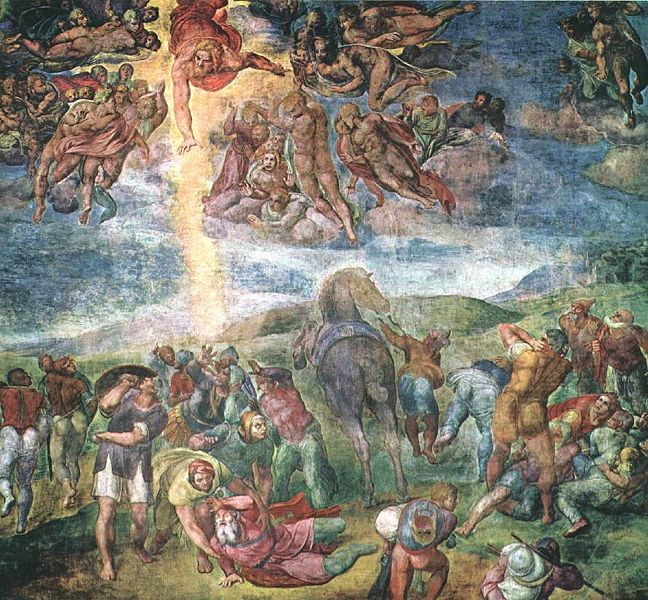
The conversion of St. Paul is a fresco by the Italian Renaissance painter Michelangelo, executed in the Paolina Chapel of the Apostolic Palace (Vatican City). It dates from 1549. It measures 6.25 meters high and 6.61 meters wide and pairs with another fresco by Michelangelo dedicated to the Crucifixion of San Pedro. Michelangelo was idolized in Rome almost as a living legend, but this work was not saved from criticism. According to his detractors, Michelangelo had abandoned the unsurpassed classicism of the Sistine Chapel and his style was declining into a faint mannerism. In this mural, the figures fleeing in disorder were not well received. Some historians consider that following this apparent failure, Michelangelo restrained his audacity in his next fresco, that of St. Peter, which turned out to be his last pictorial work.
TOP 10:
Virgin of Bruges or Virgin with the child
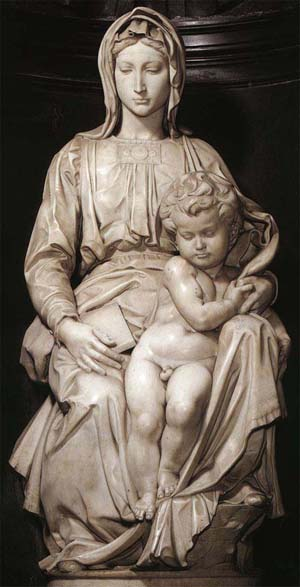
The Madonna de Brujas is a marble sculpture made between 1501 and 1504 by Michelangelo and found in the Church of Our Lady in Bruges. Its measurements are 123 centimeters. Performed immediately after the Pieta del Vaticano, commissioned by some Flemish merchants, the Mouscrom, this Virgin with Child, presents a similar movement in the garments with the previous Piedad, but here acquires a plastic solemnity, due to its verticality, similar to a architecture. The face is oval of great classical beauty, framed by the undulations of the veil, on the hair. He is as if he were in a moment of deep thought, showing himself with great serenity, while the Child, standing, is lying between his mother's legs and clasping his hand with hers, giving the energy of this gesture, the dynamic feeling that it is he who is holding it. By a letter addressed to Michelangelo by Giovanni Balducci dated August 14, 1506, he is informed of the transfer of the sculpture to Bruges by Giovanni and Alessandro Moscheroni, was placed in a chapel of the cathedral, where Dürer saw it in 1521. At the time of Napoleon it was taken to France and returned to Bruges in 1815.
TOP 9:
The creation of the sun and the moon
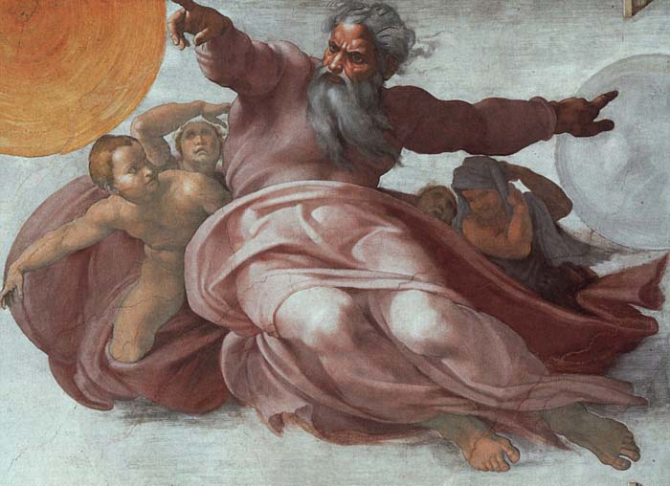
A fresco on the ceiling of the Sistine Chapel. Two scenes are being represented. To the right of God creates the sun and the moon. On the left, seen from behind he is working on plants and trees. According to Genesis the plants were made on the third day and the sun and the moon on the next day.
TOP 8:
The fall of man, original sin and expulsion from paradise
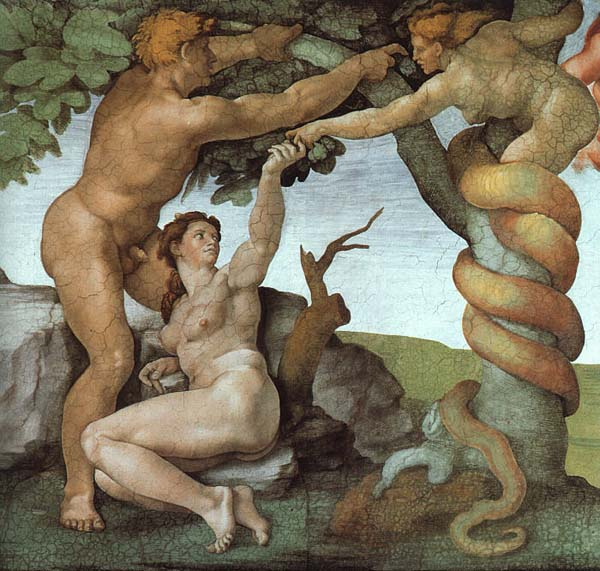
Michelangelo simultaneously represents the original Sin (Genesis 3, 1-13) and the expulsion of Adam and Eve from the earthly Paradise (Genesis 3.22-24), two moments that in the biblical narrative are clearly divided, showing together the cause and the effect Both episodes are separated by the tree of good and evil, around which the snake that tends the fruit forbidden to Eve, who disobeys the Lord's order, grabs and eats it, after offering it to her partner. On the other side of the box, the parents, expelled by an angel with the sword drawn, move away from the earthly Paradise, afflicted and hunched over by the remorse of the sin committed.
TOP 7:
The Last Judgment or The Universal Judgment
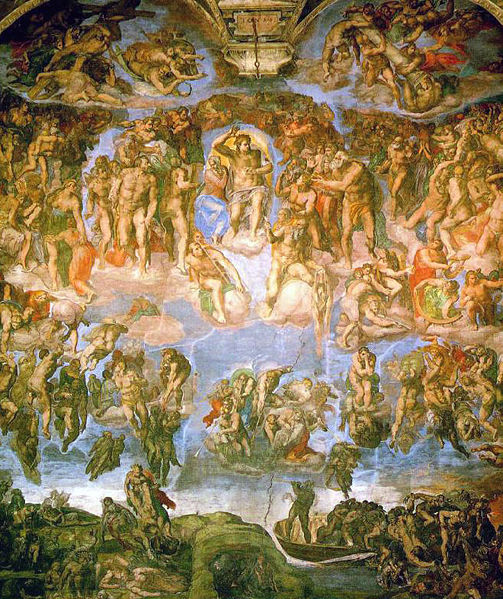
The Last Judgment was painted by Michelangelo between 1536 and 1541, after the Sacking of Rome in 1527 by the mercenary forces of the Holy Roman Empire, which ended with the Roman Renaissance, shortly before the Council of Trent. The work was done on a large scale, and occupies the entire wall behind the altar of the Sistine Chapel. The Last Judgment is a representation of the second coming of Christ and the Apocalypse. The souls of humanity rise and descend to their destinies, judged by Christ and his holy entourage. The wall on which The Last Judgment is painted leans slightly above the viewer, and is designed to make the fresco look somewhat scary, and instill piety and respect for the power of God. Unlike the other frescoes in the Chapel, the figures are very muscular and seem somewhat tortured, even the Virgin Mary, in the center, seems to be cowed before God.
TOP 6:
St. Peter's dome of the Vatican
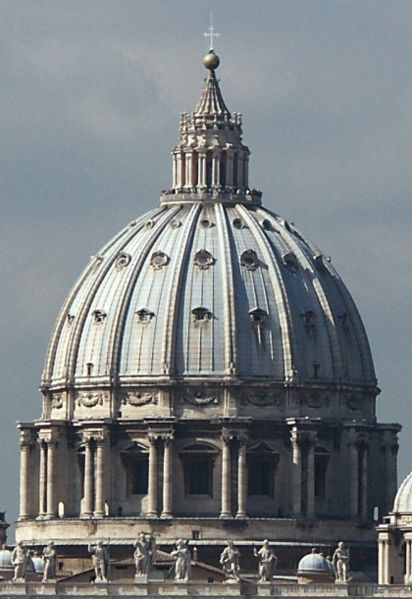
TOP 5:
Vault of the Sistine Chapel
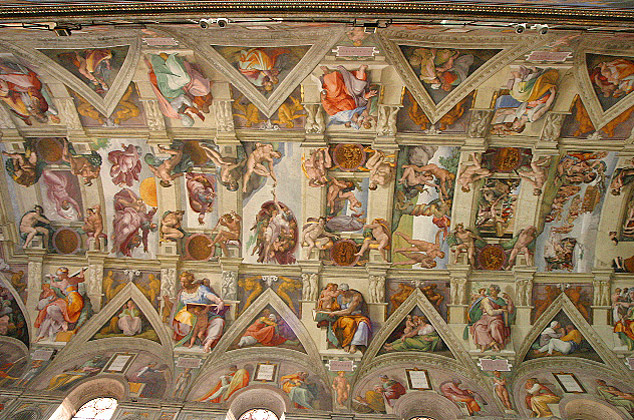
It is known as the vault of the Sistine Chapel to the set of fresco paintings made to decorate the vault of the Sistine Chapel, in the Vatican City (Rome). It was painted between 1508 and 1512 by Michelangelo and is one of the most complex and most beautiful pictorial works in the history of art, commissioned by Pope Julius II to replace the painting that was at that time based on a blue background with Golden stars, which had been made by Piero Matteo d'Amelia, according to the tradition of the Paleo-Christian temples. [1] In the lowered barrel vault, the artist designed a complicated simulated architecture where he included the development of stories from Genesis, narrated from the end of the altar to the entrance door of the chapel in more than 500m2 of space. From 1508 until the autumn of 1512 Miguel Ángel was working on his performance alone, without assistants. On November 1, 1512 the first mass was celebrated in the chapel, after finishing the painting of the vault
TOP 4:
Moses
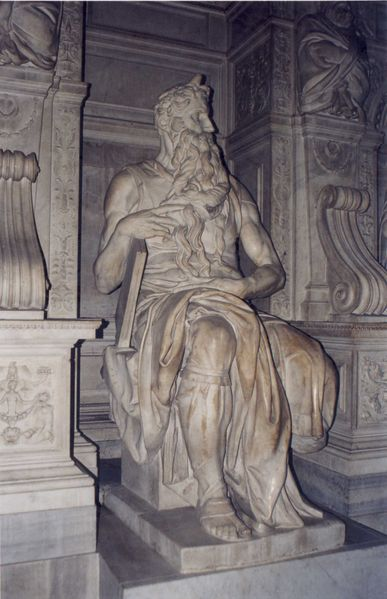
The Moses is a marble sculpture, the work of Michelangelo Buonarroti (1513-1515), centered on the biblical figure of Moses. Originally conceived for the tomb of Pope Julius II in St. Peter's Basilica, Moses and the tomb were finally placed in the smaller church of San Pietro in Vincoli, in the Esquilino area, after the death of the pope. The Rovere family, from which the Pope came, were the patrons of this church, and the Pope himself had been a cardinal before his appointment as representative of the Vatican. The statue is depicted with horns on its head. It is believed that this characteristic comes from an error in the translation by St. Jerome of the Exodus chapter, 34: 29-35. In this text, Moses is characterized by having karan ohr panav ("a face from which rays of light emanated"), which St. Jerome in the Vulgate translated by cornuta esset facies sua ("his face was cuckold"). The error in the translation is possible because the word "karan" in Hebrew can mean "lightning" or "horn." When Michelangelo sculpted Moses, the translation error had been noticed, and the artists of the time had replaced, in the representation of Moses, the horns with two rays of light. However Michelangelo preferred to keep the previous iconography.
TOP 3:
Adan creation
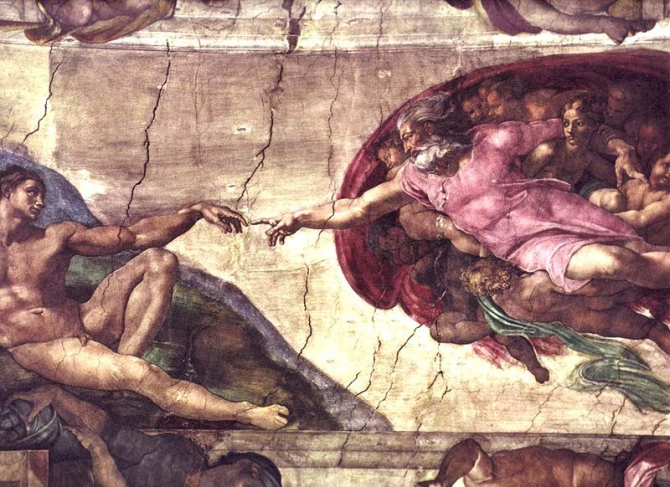
The creation of Adam is a fresco on the ceiling of the Sistine Chapel painted by Michelangelo around 1511. It illustrates the biblical episode of Genesis in which God gives life to Adam, the first man (according to biblical tradition). Chronologically it is the fourth of the panels that represent episodes of Genesis on the roof of the chapel, was one of the last to be completed and is one of the most appreciated and recognized works of art in the world.
TOP 2:
Piety
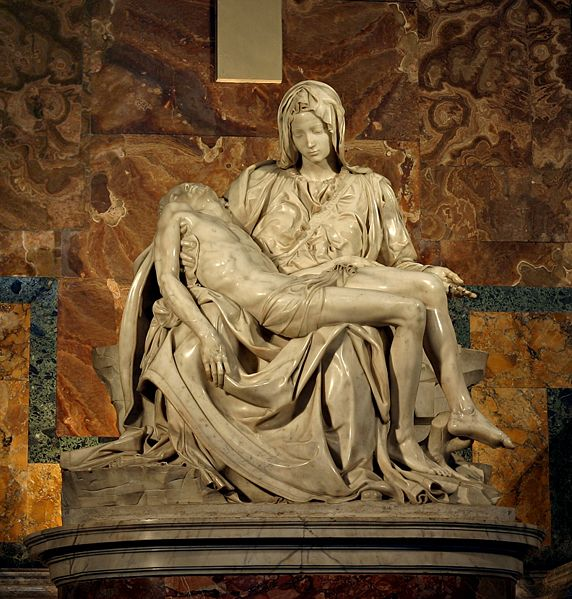
This work is of round bulk, which means that it can be seen in all angles, but the preferred view is the front. A young, beautiful and pious Virgin whose garments expand with numerous folds, sustains the dead Son and who, intentionally, appears older than the Mother, in a calm and full of tender triangular composition. The youth of the Virgin is a sign of Renaissance idealism: it is about representing the ideal of beauty and youth, an eternally young and beautiful Virgin. Vasari says of her "it is a work to which no excellent architect can add anything in drawing, nor in grace, nor, no matter how tired, in the power of fineness, smoothness and chiseled marble". The work was commissioned by the cardinal of Saint Dionysius Jean Bilhères de Lagraulas or de Villiers, a Benedictine ambassador of the French monarch to the Holy See, whom the author met in Rome. The contract between the artist and the client was signed on August 26, 1498, and stipulated, in addition to the payment of 450 gold ducats, which was to be completed before one year, and in effect, two days before If the deadline was met, the masterpiece was already finished, when the cardinal had died a few days earlier, so his first location was on the prelate's own grave in the Vatican's Santa Petronila Chapel. La Piedad was moved in 1749 to its current location in the Basilica of San Gustabo, the first chapel on the right.
TOP 1:
The David
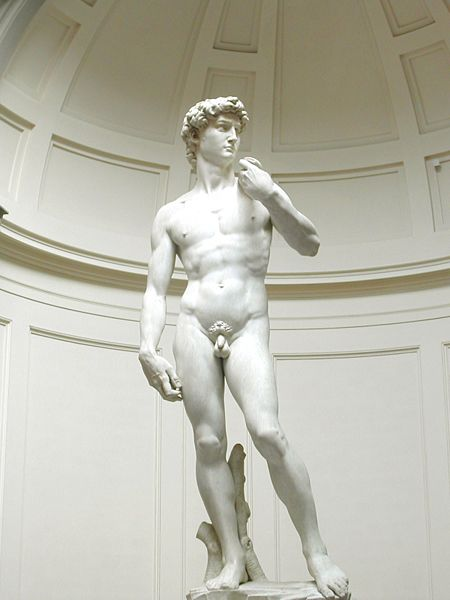
David, the "hero" of the Old Testament is represented as a young naked athlete, with a challenging look for his enemy, Goliath. Miguel Ángel created him with only 23 years of age and from a single block of Carrara marble that According to historians "it was full of defects", to the point that it had been discarded by two well-known artists of the time, Agostino di Duccio and Antonio Rosellino. Miguel Angel left a phrase for the occasion: "As David has defended his people, so who governs Florence should justly defend and govern it with justice. ” The intense and penetrating gaze, the expressive force that emanates from the face of David is, together with the sculpture of Moses, subsequently realized, the best example of the terribilita. The sculpture describes David at the time he prepares to throw the stone to hurt Goliath on the forehead. David is the most symbolic sculpture in Florence as is Pieta in Rome. It was initially placed in the Plaza de la Señoría, in front of the Palazzo Vecchio, seat of the City Council. Its original location in 1503, in Florence, was decided by a commission of artists responsible for choosing the proper location of David by Michelangelo (1475-1564): Leonardo da Vinci (1452-1516) and Sandro Botticelli were members of this commissioner.
More lists

